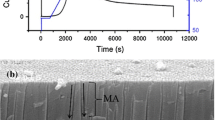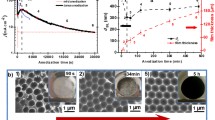Abstract
In the present work, hard anodization assisted by anode temperature ramp was employed to fabricate self-ordered nanoporous alumina in the wide range of interpore distances (259–405 nm) in pure oxalic acid and mixture of oxalic and phosphoric acid solutions. Anode temperature ramp technique was employed to adjust the anodization current density to optimize the self-ordering of the nanopore arrays in the interpore range in which no ordered self-assembled hard anodized anodic aluminum oxide has reported. It is found that the certain ratios of oxalic and phosphoric acid solutions in this anodization technique increased self-ordering of the nanopores especially for anodization voltages over the 170 V by increasing alumina’s viscous flow which could lead to decrease the overall current density of anodization, yet leveled up by anode temperature ramp. However, below 150 V anodization voltage, the ratio of interpore distance to the anodization voltage of the both anodization techniques was the same (~2 nm/V), while above this voltage, it increased to about 2.2 nm/V.






Similar content being viewed by others
References
H. Masuda, K. Fukuda, Ordered metal nanohole arrays made by a two-step replication of honeycomb structures of anodic alumina. Science 268, 1466–1468 (1995). doi:10.1126/science.268.5216.1466
H. Masuda, M. Satoh, Fabrication of gold nanodot array using anodic porous alumina as an evaporation mask. Jpn. J. Appl. Phys. 35, L126 (1996)
E.P. Gusev et al., High-resolution depth profiling in ultrathin Al2O3 films on Si. Appl. Phys. Lett. 76, 176–178 (2000). doi:10.1063/1.125694
C. Liu et al., An all-in-one nanopore battery array. Nat. Nanotechnol. 9, 1031–1039 (2014). doi:10.1038/nnano.2014.247. http://www.nature.com/nnano/journal/v9/n12/abs/nnano.2014.247.html#supplementary-information
S. Zhao et al., Statistical study of effective anisotropy field in ordered ferromagnetic nanowire arrays. J. Nanosci. Nanotechnol. 7(1), 381–386 (2007)
S. Zhao et al., New application of AAO template: a mold for nanoring and nanocone arrays. J. Am. Chem. Soc. 128(38), 12352–12353 (2006)
X. Zhang et al., Fabrication of highly ordered InSb nanowire arrays by electrodeposition in porous anodic alumina membranes. J. Electrochem. Soc. 152(10), C664–C668 (2005)
M. Lahav et al., Core−shell and Segmented polymer−metal composite nanostructures. Nano Lett. 6(9), 2166–2171 (2006)
M. Hideki, Y. Kouichi, O. Atsushi, Self-ordering of cell configuration of anodic porous alumina with large-size pores in phosphoric acid solution. Jpn. J. Appl. Phys. 37(11A), L1340 (1998)
A.P. Li et al., Hexagonal pore arrays with a 50–420 nm interpore distance formed by self-organization in anodic alumina. J. Appl. Phys. 84(11), 6023–6026 (1998)
O. Jessensky, F. Müller, U. Gösele, Self-organized formation of hexagonal pore arrays in anodic alumina. Appl. Phys. Lett. 72(10), 1173–1175 (1998)
J. Choi et al., Perfect two-dimensional porous alumina photonic crystals with duplex oxide layers. J. Appl. Phys. 94(8), 4757–4762 (2003)
W. Lee, S.-J. Park, Porous anodic aluminum oxide: anodization and templated synthesis of functional nanostructures. Chem. Rev. 114, 7487–7556 (2014). doi:10.1021/cr500002z
H. Masuda, K. Yada, A. Osaka, Self-ordering of cell configuration of anodic porous alumina with large-size pores in phosphoric acid solution. Jpn. J. Appl. Phys. 37, L1340 (1998)
S. Shingubara et al., Self-organization of a porous alumina nanohole array using a sulfuric/oxalic acid mixture as electrolyte. Electrochem. Solid State Lett. 7(3), E15–E17 (2004)
M.A. Kashi et al., Optimum self-ordered nanopore arrays with 130–270 nm interpore distances formed by hard anodization in sulfuric/oxalic acid mixtures. J. Phys. D Appl. Phys. 40(22), 7032 (2007)
M.A. Kashi et al., The effect of pH and composition of sulfuric–oxalic acid mixture on the self-ordering configuration of high porosity alumina nanohole arrays. J. Phys. D Appl. Phys. 40(15), 4625 (2007)
S.Z. Chu et al., Large-scale fabrication of ordered nanoporous alumina films with arbitrary pore intervals by critical-potential anodization. J. Electrochem. Soc. 153, B384–B391 (2006). doi:10.1149/1.2218822
W. Lee et al., Fast fabrication of long-range ordered porous alumina membranes by hard anodization. Nat. Mater. 5, 741–747 (2006)
Y. Li et al., Fabrication of highly ordered nanoporous alumina films by stable high-field anodization. Nanotechnology 17, 5101 (2006)
K. Schwirn et al., Self-ordered anodic aluminum oxide formed by H2SO4 hard anodization. ACS Nano 2, 302–310 (2008). doi:10.1021/nn7001322
M.A. Kashi et al., Self-ordering of anodic nanoporous alumina fabricated by accelerated mild anodization method. Thin Solid Films 518(23), 6767–6772 (2010)
M.A. Kashi et al., Fabrication of self-ordered nanoporous alumina with 69–115 nm interpore distances in sulfuric/oxalic acid mixtures by hard anodization. Jpn. J. Appl. Phys. 49, 015202 (2010)
G.E. Thompson, G.C. Wood, Porous anodic film formation on aluminium. Nature 290, 230–232 (1981)
H. Han et al., In situ determination of the pore opening point during wet-chemical etching of the barrier layer of porous anodic aluminum oxide: nonuniform impurity distribution in anodic oxide. ACS Appl. Mater. Interfaces 5, 3441–3448 (2013). doi:10.1021/am400520d
L. Vojkuvka et al., On the mechanical properties of nanoporous anodized alumina by nanoindentation and sliding tests. Surf. Coat. Technol. 206, 2115–2124 (2012). doi:10.1016/j.surfcoat.2011.09.040
S. Garcia-Vergara et al., Growth of porous anodic films on sputtering-deposited aluminium incorporating Al–Hf alloy nanolayers. Electrochim. Acta 54, 3662–3670 (2009)
K.R. Hebert, J.E. Houser, A model for coupled electrical migration and stress-driven transport in anodic oxide films. J. Electrochem. Soc. 156, C275–C281 (2009). doi:10.1149/1.3151835
J.E. Houser, K.R. Hebert, The role of viscous flow of oxide in the growth of self-ordered porous anodic alumina films. Nat. Mater. 8, 415–420 (2009). http://www.nature.com/nmat/journal/v8/n5/suppinfo/nmat2423_S1.html
M.M. Lohrengel, Thin anodic oxide layers on aluminium and other valve metals: high field regime. Mater. Sci. Eng. R 11, 243–294 (1993). doi:10.1016/0927-796X(93)90005-N
A.C. Harkness, L. Young, High resistance anodic oxide films on aluminium. Can. J. Chem. 44, 2409–2413 (1966). doi:10.1139/v66-363
Acknowledgments
Authors are grateful to the University of Kashan for supporting this work by Grant No. (159023/16).
Author information
Authors and Affiliations
Corresponding author
Rights and permissions
About this article
Cite this article
Mohammadniaei, M., Maleki, K., Kashi, M.A. et al. Self-ordered nanopore arrays through hard anodization assisted by anode temperature ramp. Appl. Phys. A 122, 915 (2016). https://doi.org/10.1007/s00339-016-0446-4
Received:
Accepted:
Published:
DOI: https://doi.org/10.1007/s00339-016-0446-4




